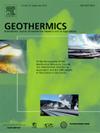油藏冷却诱发远场断层再激活的数值分析
IF 3.5
2区 工程技术
Q3 ENERGY & FUELS
引用次数: 0
摘要
本研究提出了一个热-水-机械框架来模拟一个简化的断层合成油藏中的热液系统,复制了荷兰和德国目前的生产情况。储层由多孔且渗透性强的砂岩组成,围合层由多孔但渗透性较差的页岩组成,经历了注入冷水、提取热水的过程。对距注入井750米的断层进行了调查,以检查断层滑动可能发生的条件。模拟了各种断层和地层的刚度,以评估它们对断层稳定性的影响。我们的分析表明,热液操作引起的应力变化可能导致断层重新激活,而储层和围岩层之间的刚度对比对断层重新激活的时间和地点起着重要作用。更硬的约束层导致与冷却锋通过更密切相关的再激活。相反,较硬的储层会导致更大、更平缓的应力变化,这使得再激活与冷却岩石的总体积关系更密切。本文章由计算机程序翻译,如有差异,请以英文原文为准。
Numerical analysis of far-field fault reactivation induced by reservoir cooling
This study presents a thermo-hydro-mechanical framework to model hydrothermal systems within a simplified faulted synthetic reservoir, replicating current production scenarios in The Netherlands and Germany. The reservoir, composed of porous and permeable sandstone, and the confining layer, made of porous but less permeable shale, undergoes a process where cold water is injected and hot water is extracted. A fault, situated 750 meters from the injection well, is investigated to examine the conditions when fault slip could occur. Various fault and formation stiffnesses are modeled to assess their impact on fault stability. Our analysis reveals that stress changes induced by hydrothermal operations can lead to fault reactivation, with the stiffness contrast between the reservoir and confining layers playing a significant role in when and where fault reactivation can occur. Stiffer confining layers lead to reactivation occurring more closely associated with the passage of the cooling front. In contrast, a stiffer reservoir results in greater and more gradual stress changes, making reactivation more closely related to the total volume of cooled rock.
求助全文
通过发布文献求助,成功后即可免费获取论文全文。
去求助
来源期刊

Geothermics
工程技术-地球科学综合
CiteScore
7.70
自引率
15.40%
发文量
237
审稿时长
4.5 months
期刊介绍:
Geothermics is an international journal devoted to the research and development of geothermal energy. The International Board of Editors of Geothermics, which comprises specialists in the various aspects of geothermal resources, exploration and development, guarantees the balanced, comprehensive view of scientific and technological developments in this promising energy field.
It promulgates the state of the art and science of geothermal energy, its exploration and exploitation through a regular exchange of information from all parts of the world. The journal publishes articles dealing with the theory, exploration techniques and all aspects of the utilization of geothermal resources. Geothermics serves as the scientific house, or exchange medium, through which the growing community of geothermal specialists can provide and receive information.
 求助内容:
求助内容: 应助结果提醒方式:
应助结果提醒方式:


